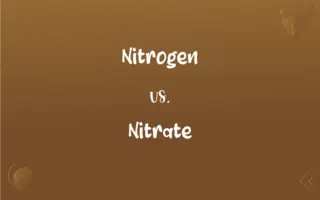Burette vs. Pipette: What's the Difference?
Edited by Aimie Carlson || By Janet White || Published on December 6, 2023
A burette is a graduated glass tube with a tap for delivering known volumes of a liquid, while a pipette is a slender tube for transferring or measuring small volumes of liquid.

Key Differences
A burette is a long, cylindrical glass tube with graduation marks and a valve or stopcock at the bottom, allowing controlled liquid release. A pipette, in contrast, is typically a slender glass or plastic tube, sometimes with a bulb, used for transferring or measuring small liquid amounts.
Burettes are designed for dispensing variable, but precise, volumes of liquid, often used in titrations where accuracy is critical. Pipettes are used for accurately measuring and transferring fixed volumes, essential in many laboratory procedures.
In a laboratory, a burette is commonly used in quantitative chemical analysis, especially titration, to determine unknown concentrations. Pipettes are used in various laboratory applications, from chemistry to biology, for transferring precise volumes of liquids.
There are different types of burettes, like straight and digital burettes. Pipettes come in several forms, including volumetric, graduated, and Pasteur pipettes, each serving specific purposes.
Operating a burette involves adjusting the valve or stopcock to control liquid flow. Pipettes require the use of a pipette filler or a bulb to draw and release liquid.
ADVERTISEMENT
Comparison Chart
Design
Graduated tube with a valve at bottom
Slender tube, sometimes with a bulb
Precision
Dispenses variable, precise volumes
Measures and transfers fixed volumes
Lab Use
Used in titrations for analysis
Used for transferring liquids
Types
Straight, digital burettes, etc.
Volumetric, graduated, Pasteur, etc.
Operation
Valve or stopcock controls flow
Uses a filler or bulb for operation
ADVERTISEMENT
Burette and Pipette Definitions
Burette
A burette allows controlled release of variable volumes.
She adjusted the burette's stopcock to add the reactant dropwise.
Pipette
Pipettes ensure precise volume control in experiments.
Accurate pipetting was essential for the biochemical assay.
Burette
Burettes are commonly used in chemical titrations.
The burette's precise measurements made the titration results reliable.
Pipette
Volumetric pipettes are used for exact volume measurements.
She filled the volumetric pipette to the mark for precise dilution.
Burette
A burette is a graduated glass tube for precise liquid dispensing.
The chemist used a burette for the acid titration experiment.
Pipette
Pasteur pipettes are useful for general liquid transfer.
A Pasteur pipette was used to add samples to the culture dish.
Burette
Burettes are integral in quantitative analysis.
Accurate readings from the burette were crucial for the experiment's success.
Pipette
A pipette is a lab tool for measuring and transferring liquids.
He used a pipette to transfer the solution to the test tube.
Burette
Digital burettes provide enhanced accuracy and ease of use.
He preferred using a digital burette for its readability and precision.
Pipette
Pipettes are indispensable in molecular biology labs.
The researcher used a micropipette for the DNA extraction process.
Burette
A glass tube with fine, volumetric graduations and a stopcock at the bottom, used especially in laboratory procedures for accurate fluid dispensing and measurement.
Pipette
A narrow, usually calibrated tube into which small amounts of liquid are suctioned for transfer or measurement.
Burette
(chemistry) A glass tube with fine gradations and a stopcock at the bottom, used in laboratory procedures for accurate fluid dispensing and titration.
Pipette
(sciences) A small tube, often with an enlargement or bulb in the middle, and usually graduated, used for transferring or delivering measured quantities of a liquid.
Burette
(religion) An altar cruet.
Pipette
To transfer or measure the volume of a liquid using a pipette.
Burette
An apparatus for delivering measured quantities of liquid or for measuring the quantity of liquid or gas received or discharged. It consists essentially of a graduated glass tube, usually furnished with a small aperture and stopcock.
Pipette
A small glass tube, often with an enlargement or bulb in the middle, and usually graduated, - used for transferring or delivering measured quantities.
Burette
Measuring instrument consisting of a graduated glass tube with a tap at the bottom; used for titration
Pipette
Measuring instrument consisting of a graduated glass tube used to measure or transfer precise volumes of a liquid by drawing the liquid up into the tube
FAQs
How is a pipette different from a burette?
A pipette is used for measuring and transferring fixed volumes, while a burette dispenses variable volumes.
Can a burette measure small volumes accurately?
Yes, burettes are designed for accurate measurements of variable volumes.
What is a burette used for?
A burette is used for dispensing precise volumes of liquid, especially in titrations.
What types of pipettes are there?
Including volumetric, graduated, and Pasteur pipettes.
How accurate is a burette?
Very accurate, crucial for tasks like titration in analytical chemistry.
Is a burette always made of glass?
Typically, but there are also plastic and digital burettes.
Are burettes only used in chemistry?
Primarily, but they can be used in any field requiring precise liquid measurement.
What is the function of a volumetric pipette?
To transfer a specific, fixed volume of liquid accurately.
What is a Pasteur pipette?
A type of pipette used for general liquid transfer, often disposable.
How do you clean a burette?
With appropriate laboratory cleaning solutions and techniques.
Is a micropipette a type of pipette?
Yes, used for very small, precise volumes, especially in biological research.
Do burettes require calibration?
Yes, to ensure their accuracy in measurements.
Are there digital pipettes?
Yes, offering precise control and ease of use.
Can pipettes be automated?
Yes, there are automated pipetting systems for high-throughput laboratory work.
Why are burettes important in titration?
They allow for the precise addition of titrant to reach the endpoint of the reaction.
How do you use a pipette?
By using a pipette filler or bulb to draw in and release the liquid.
Can pipettes be reused?
Some types, like glass volumetric pipettes, can be reused after proper cleaning.
Can a pipette be used for any liquid?
Generally, yes, but some liquids may require specific materials or types of pipettes.
What is the main use of a burette in a lab?
For quantitative chemical analysis, particularly in titration procedures.
What's the capacity of a typical burette?
Commonly from 10 mL to 100 mL.
About Author
Written by
Janet WhiteJanet White has been an esteemed writer and blogger for Difference Wiki. Holding a Master's degree in Science and Medical Journalism from the prestigious Boston University, she has consistently demonstrated her expertise and passion for her field. When she's not immersed in her work, Janet relishes her time exercising, delving into a good book, and cherishing moments with friends and family.
Edited by
Aimie CarlsonAimie Carlson, holding a master's degree in English literature, is a fervent English language enthusiast. She lends her writing talents to Difference Wiki, a prominent website that specializes in comparisons, offering readers insightful analyses that both captivate and inform.































































